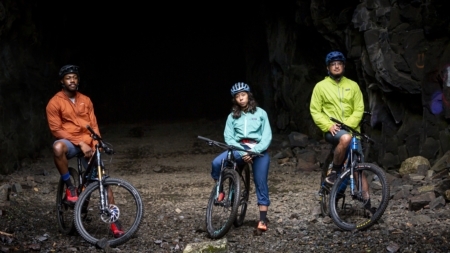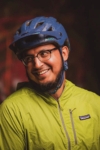Right Where I Belong
“That comfort, the ability to feel like you’re not stepping outside of some boundary; It’s not like, ‘Do I belong here?’ No, this is where I’m supposed to be.”
A Black Lives Matter sign hangs window of Venture North, and the smell of coffee greets me when I open the door. Inside, photographs and murals cover the walls, most depicting people of color from the surrounding neighborhood. None of this is surprising in context; the northern part of Minneapolis is historically Black, as are Venture North’s owners.
Yet the sign still catches my attention. Venture North is a bike shop, and bike shops are not usually comfortable places for mountain bikers of color. Instead, they tend to be sources of agony: condescending mechanics or employees who seem to require that you prove your cycling knowledge.
Unfortunately, it’s not just shops that have this effect on people of color; it’s mountain biking in general—which is exactly why we’re here.
Tracy Brown, Rachel Olzer and I just met for the first time in real life a few hours ago, at Rachel’s house a couple blocks away, but had been planning this trip for months through the Instagram account @allmountainbrothers (AMB), an online community of people of color in the outdoors, which Tracy cofounded. We all love the sport and all it offers: the beautiful trails, amazing scenery, the connection with nature. We also struggle with the lack of cultural and racial diversity within it. This is why, as a photographer, I center people of color in my imagery because we’re often excluded in narratives of the camaraderie, joy, freedom and adventure that sports provide.
Not at Venture North. Owned by Black cyclists, with its welcoming mechanics, it is exactly how I’d envision the perfect shop for the everyday rider—and, maybe someday, how mountain biking will be.
Tracy turns to me and smiles, “I feel at home here.”
For my part, I learned to mountain bike in Mammoth Lakes, California, in the early 2000s and was often the only person of color on the local downhill scene. In those early years, mountain biking was a place where I could escape stress and find freedom. Being in a small California town with a sizable Latino migrant population working in the service sector, I also heard disparaging comments about my people coming from the bike community. After a local downhill race, for example, someone bumped a table and knocked over some plates and cups. A voice rose from the back of the room. “We should get a Mexican to clean it up,” it said. Everyone laughed.
That wasn’t my first such experience, nor last. I moved to Santa Cruz, California, in 2007, both to pursue my undergraduate degree at the University of California, Santa Cruz, and for the area’s infamous trails. But I continued to be disillusioned by cycling and began to distance myself from it. At first, I just rode by myself, even though riding with others is one of my favorite parts of mountain biking. So, I just did it less. In 2009, I sold my bike and stopped entirely.
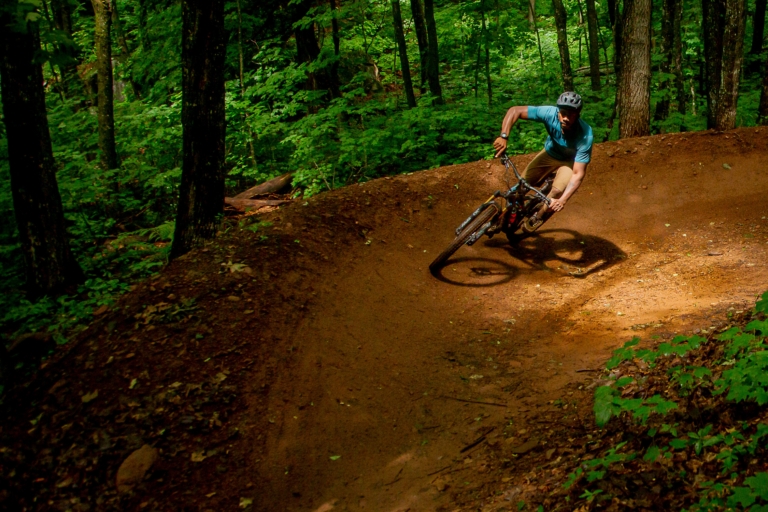
The day the crew was to visit a new trail system in Tofte, Minnesota, the forecast showed nothing but rain. Knowing they’d get drenched—but wanting to ride—they decided to go anyway and were thoroughly soaked 10 minutes after leaving the trailhead. Rachel Olzer and Eric Arce turned back, but Hansi Johnson and Tracy Brown headed to Jackpot, a new flow trail, where they caught a brief 15 minutes of sun. Hansi Johnson
Yet, I never stopped loving to ride. I missed the trails, the mountains and the benefits to my mental health. I missed how it made me feel weightless yet at the same time grounded my spirit. It was the only place I achieved a complete state of mindfulness. For an hour or two, I experienced how I was meant to be. I felt happy.
I bought my next bike in 2016 as a way to de-stress while working on my PhD in sociology at the University of California, Santa Barbara. Then, on a ride in February 2018, I crashed and broke my collarbone. At the hospital, the doctors noticed a lump on my neck and did a biopsy: thyroid cancer, operable but frightening enough to make me reevaluate my priorities. I quit grad school and moved to Salt Lake City, Utah, to focus on my photography.
First, however, I needed my thyroid removed. I hadn’t told my parents (my dad was dealing with pancreatic cancer), and I knew no one in Salt Lake besides my fiancée. In October 2018, a Lyft driver dropped me off at the hospital. A few hours later, I walked out cancer-free and more determined than ever to increase representation in the sport that had—in a weird way—saved my life.
“I missed the trails, the mountains and the benefits to my mental health. I missed how it made me feel weightless yet at the same time grounded my spirit. It was the only place I achieved a complete state of mindfulness.”
But it wasn’t until I stumbled upon other cyclists of color on Instagram that I began getting excited about building a new riding community. When I encountered AMB shortly after, I reached out to Tracy and found that the community already existed.
Tracy cofounded AMB in 2018 after a bike trip with friends Snook, Ikhide and Cory. The four—all of whom are Black—found themselves sharing stories as people of color in a largely white community and their desire to connect with others who’d had the same experience. Tracy started AMB when he got home, and the account has grown daily in the year since, garnering a global following and inbox full of messages from people grateful to see themselves reflected on AMB’s feed.
“Representation is important because we all need someone to look up to and aspire to,” Tracy says. “It goes back to the first time I saw another Black guy on the trail and the feeling I got from it. I wanted to create a space to share that, to motivate and encourage other mountain bikers of color. Most of all, I wanted to see more Black and Brown kids on mountain bikes.”
For Rachel, AMB offered a similar connection. Before becoming a professional cross-country racer, the PhD candidate in ecology, evolution and behavior at the University of Minnesota was a passionate rock climber. But while the sport itself was physically challenging, its culture was even more so.
“I think climbing is so new that there’s not as great of an awareness of how white-male dominated it really is and how unwelcoming it is to women and people of color,” she says. “Every time I went out, I felt I had to prove I belonged. I got tired of it. No matter how good I got or felt, it was never enough to make me feel accepted.”
The three of us spent months talking via direct messages and bouncing around ways to share our stories and elevate other people of color in cycling culture. We decided to take another bike trip, bringing together a diverse set of minds to focus on places and people that often go ignored in our sport. And if there’s anywhere that gets overlooked in mountain bike culture, it’s the Upper Midwest.
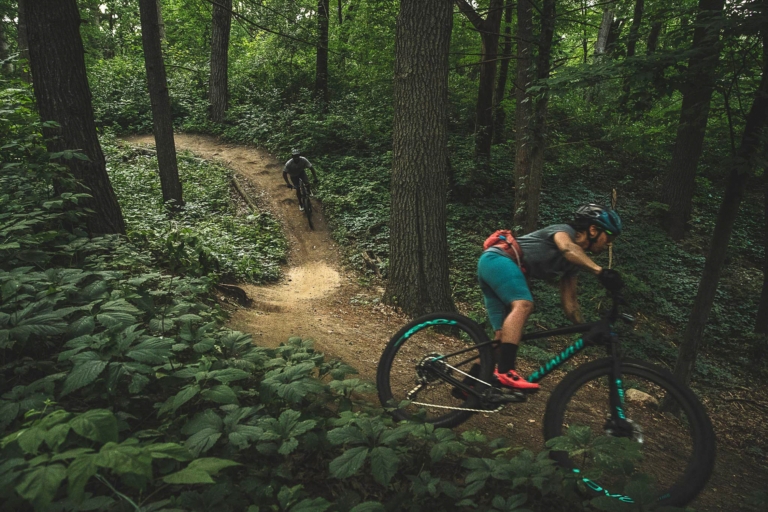
Spend a spring day on the trails around Minneapolis and you’ll experience tacky dirt, vibrant forests and Minnesota’s unofficial state bird: the mosquito. Tracy Brown and Rachel Olzer stay ahead of the swarm.
Though I pushed for more conventional (and mountainous) locations, Tracy and Rachel were both set on Minnesota. Being from Austin, Texas, Tracy had heard tales of the area’s incredible riding, and Rachel was excited to show us her home trails. Coming from Salt Lake’s Wasatch Range, I was a bit hesitant. In my mind, the Midwest was flat.
Walking out of Venture North with a coffee and a bike tube, I’d soon learn I was wrong.
We meet Hansi Johnson in an ice cream parlor in downtown Duluth. Sporting a five-o’clock shadow and a quiet smile, he doesn’t look like an advocacy powerhouse, but looks can be misleading. He’s been involved in the outdoor industry for his entire life, and as a former International Mountain Biking Association regional director, he played a crucial role in developing the area as an outdoor recreation hotspot. Now, as director of recreational lands for the Minnesota Land Trust, a St. Paul-based conservation organization, he’s used that same advocacy to help protect the state’s natural spaces.
Hansi has always considered mountain biking inclusive, but when his adopted son Tae, who is Korean American, asked why there weren’t more kids who looked like him on the trails, it opened Hansi’s eyes to the lack of diversity in the outdoor community. He’s since published articles calling out that deficit. The response wasn’t what he’d hoped. Some of his peers claimed it wasn’t a problem, while others argued the subject is too divisive. If anything, it’s made Hansi more determined.
“At some point, there’s going to be this day of reckoning with my kid,” he says, “where he’s either going to look at me as that white guy who did nothing or that white guy who did something.”
We also meet Raequan Wilson, a mountain biker from Minneapolis. A talented cross-country ski racer, Raequan is 21, full of energy and obviously proud of his hometown. He’s spent much of his life in conventional Upper Midwest pursuits like Nordic skiing and sees cycling as a way to clear his head (and find thrills on the area’s technical trails and jump lines). It’s also his job: As another person of color on the Minneapolis bike scene, Raequan works for the Loppet Foundation, an organization striving to make outdoor recreation more inclusive.
“That comfort, the ability to feel like you’re not stepping outside some boundary. It’s not like, ‘Do I belong here?’ No, this is where I’m supposed to be.”
“I coach kids of color from North Minneapolis and a range of other ages, from 4 years old up to 67,” he says. “There is nothing more fulfilling than the feeling I get when things start to click with the kids.”
After a healthy helping of ice cream, Hansi and Raequan show us around the local trail system—and thoroughly prove the Midwest is not completely flat. The gauntlet of steep features, tricky lines, rock drops and punchy climbs would be impressive (and intimidating) anywhere in the US. However, it hasn’t come easily. It’s taken two decades of hard work to create Duluth’s massive network of trails. But as we learn the next evening at a barbecue with other local mountain bikers of color in Hansi’s backyard, the system’s backbone is much older.
Duluth is the ancestral home of the Ojibwe, who call the area Misaabekong (“the place of giants”) and spent centuries preserving the land and harvesting rice on the shores of Lake Superior. The tribe is part of the larger Anishinaabe people and remains a prominent entity in the Upper Midwest—as we see when we join tribal member Alicia Kozlowski on the nearby Fond du Lac Reservation for the final leg of the 23rd annual Anishinaabe Spirit Run, a four-day, 200-mile endurance event supporting those battling substance abuse. Running, Alicia tells us, is becoming a powerful tool for Anishinaabe communities looking to combat the effects of addiction, and afterward, she invites us to a powwow honoring those who participated. For us, it’s a powerful experience. For the runners, it’s transformative.
The next morning, Tracy and I are once again screaming our support for a new friend; this time it’s Rachel, who’s competing in a cross-country race at a local ski hill. Racing has provided Rachel with both a space to push herself and an accepting community, but she’s still often the only woman of color at events—“sometimes the only person of color,” she says. Though Tracy and I contribute nothing to the day’s race beyond excessive decibels, for Rachel it’s a reminder that she isn’t alone.
It’s raining our final morning in Duluth, but we decide to explore a trail system north of town anyway. Hansi thinks it will clear up, but it doesn’t; it gets worse, forcing Rachel and me to call it quits. Tracy and Hansi, however, are keen to keep riding, and when we meet them at the car, they’re chatting as if it were all clear skies and hero dirt. That’s one of the wonders of mountain biking: If you’re with the right people, you can have a great time even in the most ridiculous conditions.
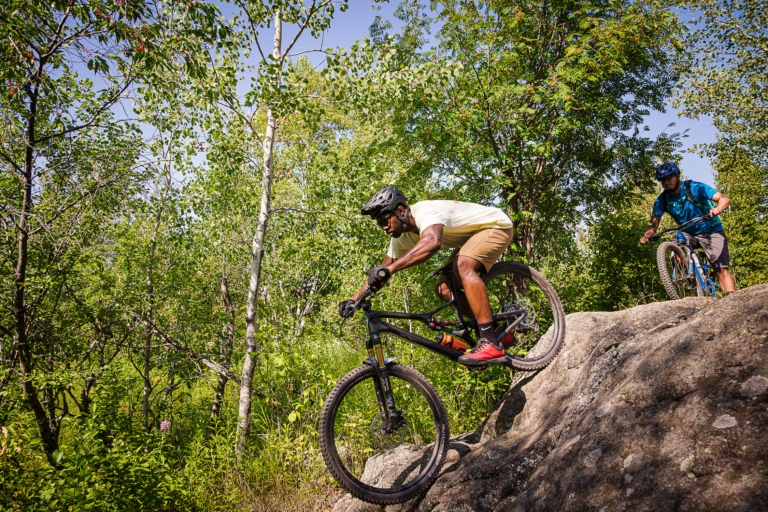
It’s a common misconception that the Upper Midwest is flat, but the trails around Duluth, Minnesota, are packed with enough challenging terrain to earn the city an International Mountain Biking Association gold-level Ride Center designation. Tracy Brown and Eric Arce get sendy on the Piedmont trail system. Hansi Johnson
I ride now more than ever because I’ve found people like Tracy, Rachel, Raequan and Hansi who understand and respect the power of this diversity—how seeing yourself reflected in mountain-bike culture makes you want to contribute to it. Inspired by our time in Duluth and Tracy’s work with AMB, Rachel and I decide to start a new Instagram handle: @pedal2thepeople, an account celebrating bikers of color in all disciplines, at all levels. It’s our attempt to replicate the comfort in being ourselves that we’d experienced on the trip.
That is why representation matters: Like Venture North, it makes mountain biking feel like home.
“To have that experience with you guys was just a dream,” Raequan later told me. “And by dream, I mean that’s actually how I imagine it’s supposed to be—that comfort, the ability to feel like you’re not stepping outside some boundary. It’s not like, ‘Do I belong here?’ No, this is where I’m supposed to be. And it sheds a different light on how things could be.”
